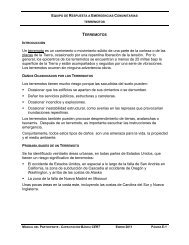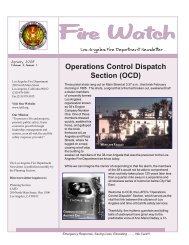FAMILY STEPS TO SURVIVAL - CERT Los Angeles
FAMILY STEPS TO SURVIVAL - CERT Los Angeles
FAMILY STEPS TO SURVIVAL - CERT Los Angeles
You also want an ePaper? Increase the reach of your titles
YUMPU automatically turns print PDFs into web optimized ePapers that Google loves.
Storage<br />
There are several options for storing your emergency<br />
supplies, including:<br />
□ Backpacks<br />
□ Duffel bags<br />
□ Heavy plastic trash cans with wheels<br />
□ Other containers<br />
One of the most important considerations in storing your<br />
supplies is determining a location that you’ll have access to<br />
after a major earthquake or other disaster. At least two<br />
different locations are recommended.<br />
Identify the safe spots in your house as you did when you<br />
developed your family emergency plan and conducted your<br />
home hazard hunt. Then, determine the locations in which<br />
you spend the most time and to which you’ll have easy<br />
access.<br />
Your options may include storing the supplies in the<br />
following locations:<br />
□ Under your bed<br />
□ In a hallway closet<br />
□ In the den<br />
□ In another location<br />
□ In more than one location such as in a backpack to<br />
take with you if you have to leave your home and in the<br />
pantry for use while you’re at home.<br />
ESP <strong>FAMILY</strong> S TEPS <strong>TO</strong> S URVIVAL / S TEP 2 , S IDE 2<br />
You also might consider storing some of the supplies in<br />
different locations. For example:<br />
Supply Location<br />
Flashlight under/by your bed<br />
Sturdy shoes under/by your bed<br />
Portable radio under/by your bed<br />
Eye glasses under/by your bed<br />
Canes, walkers, etc. by your bed<br />
Adjustable wrench at the gas meter<br />
Food, water in the pantry<br />
Remember, however, that food and water require special<br />
considerations:<br />
□ Empty open packages of sugar, flour, dried fruits and<br />
nuts into screw-top plastic jars or air-tight containers to<br />
avoid problems with insects and rodents.<br />
□ Place food and water stored in the pantry on lower<br />
shelves to prevent damage to the container.<br />
□ Store your food and water in a dark, cool place to<br />
increase their life span.<br />
□ Do not place plastic containers directly on cement<br />
floors. Lead and other contaminants may leak into the<br />
food or water if the container is placed on cement.<br />
This project was supported by FY07 UASI funding awarded by the California Emergency<br />
Management Agency, through FEMA/DHS.<br />
This information sheet is produced as part of the Emergency Survival Program<br />
(ESP). ESP is an awareness campaign designed to increase home,<br />
neighborhood, business and school emergency preparedness. ESP was<br />
developed by the County of <strong>Los</strong> <strong>Angeles</strong>. The California Emergency<br />
Management Agency (Cal EMA) and representatives from Contra Costa,<br />
Imperial, Inyo, Kern, <strong>Los</strong> <strong>Angeles</strong>, Marin, Mono, Orange, Riverside, San<br />
Bernardino, San Diego, San Luis Obispo, Santa Barbara, Santa Cruz, and<br />
Ventura counties, Southern California Edison, the Southern California Earthquake<br />
Center and the American Red Cross assist in the development of campaign<br />
materials and coordination of the campaign.




